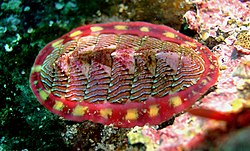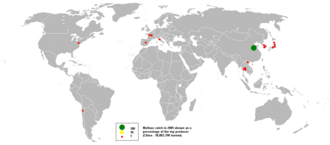Difference between revisions of "AY Honors/Shells - Advanced/Answer Key"
m (1 revision from w:Mollusca) |
m (Transwiki:Mollusca moved to AY Honor Shells - Advanced: transwiki merge) |
Revision as of 03:23, 2 August 2008
Molluscs (British spelling) or mollusks (American spelling) are animals belonging to phylum Mollusca. The word mollusc is derived from the French mollusque, which originated from the Latin molluscus, meaning thin-shelled, from mollis, soft&. The scientific study of molluscs is known as malacology.
There are around 100,000 extant species within the phylum& with an estimated 70,000 extinct species&. They range widely in size from micromolluskan snails and clams to larger organisms such as the Colossal Squid, believed to be the world's largest invertebrate. Molluscs are typically divided into ten taxonomic classes, of which two are entirely extinct&&. Class Cephalopoda molluscs such as squid, cuttlefish and octopus are among the most neurologically-advanced of all invertebrates&.
The majority of mollusc species live in marine environments, and many of them are found intertidally, in the shallow subtidal and on the continental shelf. Pelagic species of octopus and squid live throughout the water column of the ocean, and some species of clam and limpet live in the abyssal depths of the oceans around hot hydrothermal vents. However, not all molluscs are marine: the bivalve and gastropod classes also contain freshwater species, and the gastropods additionally have representatives that live on land, the land snails and slugs.
A number of species of molluscs are valued by humans as seafood, or for their decorative shells. Edible species include various clams, snails, squid and octopuses.
Anatomy
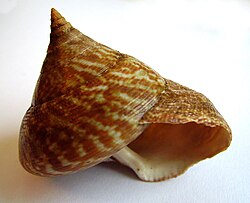
Molluscs are triploblastic protostomes and many demonstrate bilateral symmetry. The principal body cavity is a blood-filled hemocoel. They have a true coelom (eucoelom); any coelomic cavities have been reduced to vestiges around the hearts, gonads, and metanephridia (kidney-like organs). The body is often divided into a head, with eyes or tentacles, a muscular foot, and a visceral mass housing the organs.
Molluscs have a mantle, which is a fold of the outer skin lining the shell, and a muscular foot that in most species is used for locomotion. In most molluscs the mantle secretes a calcium carbonate external shell. In the majority of marine molluscs the gill or gills absorbs oxygen from the water.
All species of the phylum Molluscs have a complete digestive tract that starts from the mouth and runs to the anus. Many have a feeding structure, the radula, mostly composed of chitin. This radula is a feature only found in molluscs. Radulae are very diverse within the Mollusca, ranging from structures used to scrape algae off rocks, to the harpoon-like structures of cone snails. Cephalopods (squid, octopuses, cuttlefish) also possess a chitinous beak. Unlike the closely related annelids, molluscs lack body segmentation.
Development passes through one or two trochophore stages, one of which, (the veliger), is unique to the group. These larval stages suggest a close relationship between the molluscs and various other protostomes, notably the Annelids.
The giant squid, which until recently had not been observed alive in its adult form,& is one of the largest invertebrates; however the colossal squid is even larger.Template:Fact
Classification
There are ten classes of molluscs; eight of the classes have living representatives, the other two classes are known only from fossils. More than 250,000 species of mollusc are recognized and named. Snails (Gastropoda) account for about 80% of living mollusc diversity.&
| Class | Major organisms | Extant species | Distribution |
| Caudofoveata | worm-like organisms | 70 | deep ocean |
| Aplacophora | solenogasters, worm-like organisms | 250 | deep ocean |
| Polyplacophora | chitons | 600 | rocky marine shorelines |
| Monoplacophora | limpet-like organisms | 11 | deep ocean |
| Gastropoda | abalone, limpets, conch, nudibranchs, sea hares, sea butterfly, snails, slugs | 150,000& | marine, freshwater, land |
| Cephalopoda | squid, octopus, cuttlefish, nautilus | 786 | marine |
| Bivalvia | clams, oysters, scallops, mussels | 8000 | marine, freshwater |
| Scaphopoda | tusk shells | 350 | marine |
| Rostroconchia † | fossils; probable ancestors of bivalves | extinct | — |
| Helcionelloida † | fossils; snail-like organisms such as Latouchella | extinct | — |
Evolution
| Caudofoveata (?) | |||||
| Aplacophora | |||||
| hypothetical | Polyplacophora | ||||
| ancestral | Monoplacophora | ||||
| mollusc | Gastropoda | ||||
| Cephalopoda | |||||
| Bivalvia | |||||
| Scaphopoda |
It is believed that the bivalves and scaphopods are sister groups, as are the gastropods and cephalopods, as indicated in the relationship diagram to the right&.
In this phylum's level of organization, organ systems from all three primary germ layers can be found:
- Nervous system (with brain)
- Excretory system (nephridium or nephridia)
- Circulatory system (open circulatory system - except cephalopods which have a closed system)
- Respiratory system (gills or lungs)
All major molluscan groups possess a skeleton, though it has been lost through evolution in some members of the phylum. It is probable that the pre-Cambrian ancestor of the molluscs had calcium carbonate spicules embedded in its mantle and outer tissues, as is the case in some modern members.
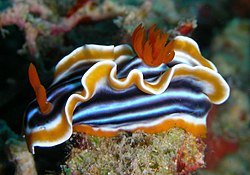
The skeleton, if present, is primarily external and composed of calcium carbonate (aragonite or calcite). The snail shell or gastropod shell is perhaps the best known molluscan shell, but many pulmonate and opisthobranch snails have secondarily reduced and internalized shells, or have lost the shell completely. The bivalve or clam shell consists of two pieces (valves), articulated by muscles and an elastic hinge. The cephalopod shell was ancestrally external and chambered, as exemplified by the ammonoids and nautiloids, and still possessed by Nautilus today. Other cephalopods, such as cuttlefish, have internalized the shell, the squid have mostly organic chitinous internal shells, and the octopods have lost the shell altogether.
The first definitive evidence for molluscs comes from an early Cambrian radula,& but the Ediacaran organism Kimberella is held by some to be an ancestral mollusc.
Dangerous molluscs
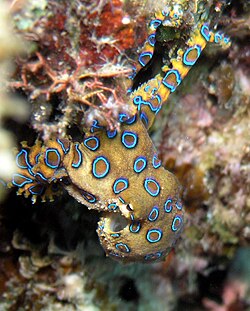
A very small minority of molluscs can represent a serious risk to humans under the wrong circumstances.
All octopuses are venomous& but only a few species pose a significant threat to humans, such as octopuses in the genus Hapalochlaena which have a very poisonous bite. A few of the larger tropical cone snail species have a very poisonous sting. These bites and stings can sometimes be fatal.
Some people are severely allergic to shellfish as a food item. However, even for people without these allergies, clams can sometimes be risky to eat. When there is a "red tide", or other blooms of noxious plankton, or when there are high concentrations of bacteria in the water from sewage run-off, bivalves such as clams and mussels can temporarily become very problematic as a food source. This is because bivalves are filter-feeders, and thus they can concentrate toxins from floating microorganisms within their tissues.
The traditional idea that the giant clam can trap the leg of a person between its valves, thus drowning them, has been shown to be a myth.
Despite its name, the disease molluscum contagiosum is caused by a virus, and is not connected with molluscs in any way.
Aquaculture
In 2005, China accounted for 80 per cent of the global mollusc catch according to a FAO study.& Within Europe, France remained the industry leader.
Template:Sisterlinks Template:Wikispecies Template:Wikibookspar
References
- ↑ Mollusc. (n.d.). The American Heritage Dictionary of the English Language, Fourth Edition. Retrieved March 19, 2008, from Dictionary.com website: http://dictionary.reference.com/browse/mollusc
- ↑ 2.0 2.1 2.2 Barnes, R.S.K., Calow, P., Olive, P.J.W., Golding, D.W. and Spicer, J.I. (2001). The Invertebrates, A Synthesis (3rd Edition), Blackwell Science, UK.
- ↑ 3.0 3.1 Brusca, R.C. & Brusca, G.J. (2003). Invertebrates (2nd Edition), Sinauer Associates Inc., MA, USA.
- ↑ Kubodera, T. & Mori, K. (2005) Template:PDFlink Proceedings of the Royal Society B: Biological Sciences 272 (1581), 2583-2586.
- ↑ Ponder, Winston F. and Lindberg, David R. (Eds.) (2008) Phylogeny and Evolution of the Mollusca. Berkeley: University of California Press. 481 pp. ISBN 978-0520250925.
- ↑ Ponder, Winston F. and Lindberg, David R. (Eds.) (2008) Phylogeny and Evolution of the Mollusca. Berkeley: University of California Press. 481 pp. ISBN 978-0520250925.
- ↑ Brusca & Brusca (1990). Invertebrates. Sunderland, Mass.: Sinauer Associates.
- ↑ Template:Cite journal
- ↑ Anderson, R.C. (1995) Aquarium husbandry of the giant Pacific octopus. Drum and Croaker 26:14-23
- ↑ China catches almost 11m tonnes of molluscs in 2005
General references
- Starr & Taggart (2002). Biology: The Unity and Diversity of Life. Pacific Grove, California: Thomson Learning.
- Nunn, J.D., Smith, S.M., Picton, B.E. and McGrath, D. 202. Checklist, atlas of distribution and bibliography for the marine mollusca of Ireland. in. Marine Biodiversity in Ireland and Adjacent Waters. Ulster Museum. publication no. 8.
- Ponder, Winston F. and Lindberg, David R. (Eds.) (2008) Phylogeny and Evolution of the Mollusca. Berkeley: University of California Press. 481 pp. ISBN 978-0520250925.
External links
ar:رخويات zh-min-nan:Nńg-thé tōng-bu̍t bg:Мекотели ca:Mol·lusc cs:Měkkýši cy:Molwsg da:Bløddyr de:Weichtiere et:Limused el:Μαλάκια es:Mollusca eo:Molusko fa:نرمتنان fr:Mollusca ko:연체동물 hr:Mekušci io:Molusko id:Mollusca ia:Mollusco is:Lindýr it:Mollusca he:רכיכות la:Mollusca lv:Moluski lb:Weechdéieren lt:Moliuskai hu:Puhatestűek mk:Мекотели nl:Weekdieren ja:軟体動物 no:Bløtdyr nn:Blautdyr oc:Mollusca pl:Mięczaki pt:Moluscos ro:Moluscă qu:Llamp'u uywa ru:Моллюски simple:Mollusc sk:Mäkkýše sl:Mehkužci sr:Мекушци fi:Nilviäiset sv:Blötdjur ta:மெல்லுடலி te:మొలస్కా th:หอย vi:Động vật thân mềm tr:Yumuşakçalar uk:Молюски zh:软体动物
